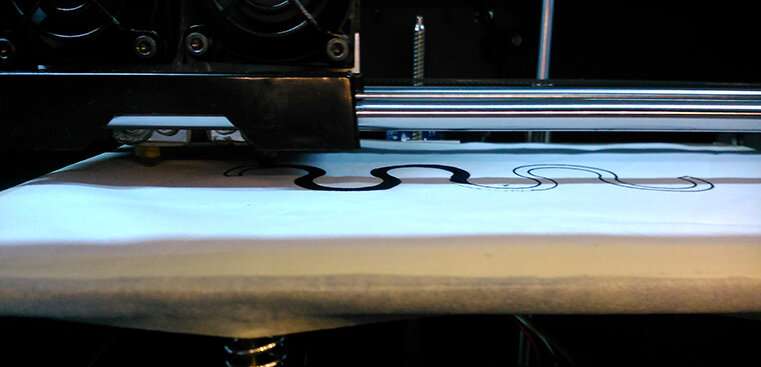A polymeric material with electrically conductive properties is 3-D-printed directly on the textile (thesis cover photo). Credit: University of Borås
Today's resource-intensive production processes for printing on textiles can soon be history. With a new method, developed within a doctoral project at the University of Borås, Sweden, several stages of the process can be cut out.
What is currently printed with screen or Inkjet technology can now be done by printing directly on the textiles with a 3-D printer. This is particularly interesting in the production of smart and functional textiles.
Doctoral student Razieh Hashemi Sanatgar has in her research project developed a new polymeric material with electrically conductive properties used as a feeding material in the 3-D printer. It is a nanocomposite, a mixture of a polymer into which she mixed electrically conductive nanofillers, including carbon nanotubes and carbon black. She has also done a systematic study of how different mixtures of these nanocomposites attach to the textile and what properties are achieved.
Benefit for the environment
The conventional printing processes used today, such as screen or Inkjet technology, require large amounts of energy, water, and chemicals. The method that has now been developed opens up great flexibility in the production process.
"The goal of my research is to develop an integrated and tailor-made production process for smart and functional textiles that simultaneously uses less water, energy, chemicals and makes less waste and thus leaves as little an imprint on the environment as possible, while at the same time being of benefit from a production point of view, as the method is both cost and resource efficient,"Razieh Hashemi Sanatgar says.
"Another benefit is that it is possible to get customised production with printing the nanocomposite directly on the textile material on the exact places needed," she explains.
Successful blend of polymer and carbon nanoparticles
One challenge in the project was to achieve and maintain the desired properties of electrically conductive 3-D printer filaments evenly after the filament has passed through the 3-D printer.
"In the project, we have succeeded in optimising the properties of the nanocomposite before and after 3-D printing, which is important to be able to control the properties and their changes after printing."
Systematic study fills knowledge gap
Another challenge was how well the polymers and nanocomposite adhere to different textile materials. The results from this part of the project fill an important gap in the research field.
"As 3-D printing on textiles is a novel technology, the adhesion of polymers and nanocomposites on textiles has not been thoroughly explored. What we have now done is a systematic study where we have investigated the effect of different printing process parameters on the adhesion of polymers and nanocomposites on textiles," she says.
Possible application areas
Examples of possible application areas for the new process method are in the production of smart bandages, VR gloves, garments with sensor and heat properties, rescue equipment, sports garments that sense body temperature, medical equipment, the automotive, aerospace and space industry, etc. that is to say in situations when you want to control exactly where the conductive material should be placed on the textile material and how the conductive property should function.
The doctoral project has been carried out within SMDTex (Sustainable Management and Design in Textiles), a doctoral programme within Erasmus Mundus on sustainable management and textile design.
More information: FDM 3-D printing of conductive polymer nanocomposites: A novel process for functional and smart textiles: hb.diva-portal.org/smash/recor … sf?pid=diva2:1349003
Provided by University of Borås
























